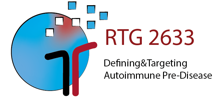B2: Inhibition of the development of pathogenic non-(a)galactosylated IgG autoantibodies.
Background. Patients who develop rheumatoid arthritis (RA) often start to express IgG autoantibodies (autoAbs) years before they develop overt clinical disease. Furthermore, healthy individuals can express IgG autoAbs without any disease symptoms. There is a correlation between the switching of the IgG Fc glycosylation pattern to more agalactosylated forms prior to the development of RA (Nat Immunol. 18:104). Accordingly, agalactosylated IgG Abs have been linked to inflammatory functions whereas galactosylated plus terminal sialylated IgG Abs have less inflammatory or anti-inflammatory properties (Front Immunol. 9:1183). Interestingly, disease improvement in RA patients as a result of anti-TNF therapy is associated with changes in the IgG Fc glycosylation. However, the mechanisms behind and the influence of other biological therapies on IgG Fc glycosylation is unclear. Our preliminary results show that the IgG Fc glycosylation pattern is determined during the germinal center (GC) reaction (J Allergy Clin Immunol. doi: 10.1016/j.jaci.2020.04.059). Furthermore, we showed in models of SLE and epidermolysis bullosa acquisita (EBA) that only those IgG autoAb-positive mice become sick, which "switched" to more agalactosylated IgG autoAbs.
Objectives. (i) Investigate the GC reaction, plasma cell (PC) and IgG (auto)Ab subclass Fc glycosylation development in "switched" and "nonswitched" mice with experimental EBA (with B1) and lupus (with A2, A6 and B1) and in ovalbumin plus adjuvant immunized mice. (ii) Explore the prophylactic and therapeutic potential of blocking/therapeutic Abs on the development of pathogenic agalactosylated IgG (auto)Abs and disease in the mouse models.
Work program. We will treat mice prophylactically or therapeutically with different blocking/therapeutic Abs to investigate the GC reaction, PC, IgG (autoAb) subclass Fc glycosylation and disease development in the mentioned mouse models. We will investigate the potential of anti-TNF, anti-IL-1, anti-IL-6 and anti-IFNalpha blocking antibodies and also the potential of glucocorticoids. For comparison we will also investigate corresponding knock-out mice. Total and/or antigen-specific IgG Fc glycosylation pattern will be investigated by HPLC and/or LC-MS and immune cells by flow cytometry.

- Projects
- A: Defining Autoimmune Pre-Disease
- B: Targeting of Autoimmune Pre-Disease
- B1: Diet as intervention in autoimmune pre-disease
- B2: Inhibition of the development of pathogenic non-(a)galactosylated IgG auto- antibodies
- B3: Controlling autoimmune-mediated disease manifestations in the lung by targeting Th2 cytokines in a novel mouse model of systemic sclerosis
- Associated projects
- MD projects
- Associated MD projects
- Concluded Projects







